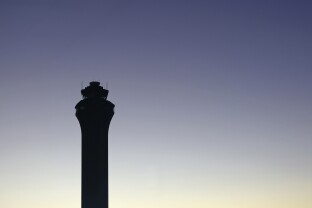While most senators mourning Wednesday’s midair collision between an Army helicopter and a commercial airliner preached patience as an investigation into the accident began, some couldn’t help but wonder: Should military helicopters be flying there in the first place?
“We need to get to the bottom of what happened,” Sen. Josh Hawley said. “And we need a thorough report. But one question I have is, why are we doing military training exercises right next to one of the busiest airports in America?”
“I don’t know if that makes the most sense to me,” Hawley added. “But that’s the kinda thing we need to figure out.”
Sen. Ted Cruz, chairman of the Senate committee that oversees the Federal Aviation Administration, also suggested the military flights should be reexamined as part of the National Transportation Safety Board’s investigation, telling reporters that having so many helicopter flights in close proximity to a commercial airport “may be a decision that should be revisited.”
“But again, those discussions should be informed by the evidence of what the investigation demonstrates when the NTSB has moved further towards reaching a conclusion,” Cruz added.
The NTSB is leading the investigation into the crash of a Black Hawk helicopter and a PSA Bombardier CRJ-701 operated by American Airlines. The airliner was carrying 60 passengers and four crew members inbound from Wichita, Kansas. It was above the Potomac River, on final approach to land at DCA, when it collided with the helicopter.
Everyone on board the plane and the three people inside the helicopter were killed.
Hawley said it might be time for some of the procedures around DCA to be revised to lessen the risk of aircraft arriving and departing what are currently well-traveled flight paths.
Kansas Sen. Roger Marshall also questioned whether the frequent overlap of military and civilian aircraft in the same airspace should continue.
“I understand that commonly happens — the military shares its shared airspace with the civilian aircraft,” Marshall told reporters. “But is that necessary? Are we just inviting a disaster to happen? And I think that’s a question that I want answered as well.”
The Black Hawk was on a routine training mission, flying southeast along the Potomac before it turned south to fly above the river and past DCA, Defense Secretary Pete Hegseth told reporters. The crew was experienced with the route, he said.
Military flights along the Potomac happen every day, often for training purposes, like the mission on Wednesday night or to ferry high-level officers and VIPs. The helicopter on Wednesday flew out of Davison Army Airfield, Hegseth released in a statement. Davison is one of multiple installations in the region.
There have been several recent close calls involving aircraft at DCA, including three in the past three years that included helicopters.
“Tragically, last night, a mistake was made,” Hegseth said at the White House, adding that there was an elevation issue that the Army and Department of Defense have started investigating.
American Airlines CEO Robert Isom said that the helicopter appeared to come into the path of the passenger jet. Audio from the air traffic controller just prior to the crash hears the controller instructing the helicopter to pass behind the passenger jet. During a press conference, Transportation Secretary Sean Duffy said that both aircraft were on flight paths that “were not unusual for what happens in the D.C. airspace.”
During a Senate Armed Services Committee hearing on Thursday, Daniel Driscoll, Trump’s pick as secretary of the Army, acknowledged lawmakers’ concerns.
“We might need to look at where is an appropriate time to take training risks, and it may not be near an airport like Reagan,” Driscoll said.
The crash is the deadliest U.S. aviation accident in over 20 years.
—
Ben T.N. Mause is a NOTUS reporter and an Allbritton Journalism Institute fellow.
This site is protected by reCAPTCHA, and the Google Privacy Policy and Terms of Service apply. By continuing on NOTUS, you agree to its Terms of Use and Privacy Policy.
Sign in
Log into your free account with your email. Don’t have one?
This site is protected by reCAPTCHA, and the Google Privacy Policy and Terms of Service apply. By continuing on NOTUS, you agree to its Terms of Use and Privacy Policy.
Check your email for a one-time code.
We sent a 4-digit code to . Enter the pin to confirm your account.
New code will be available in 1:00
Let’s try this again.
We encountered an error with the passcode sent to . Please reenter your email.
This site is protected by reCAPTCHA, and the Google Privacy Policy and Terms of Service apply. By continuing on NOTUS, you agree to its Terms of Use and Privacy Policy.


